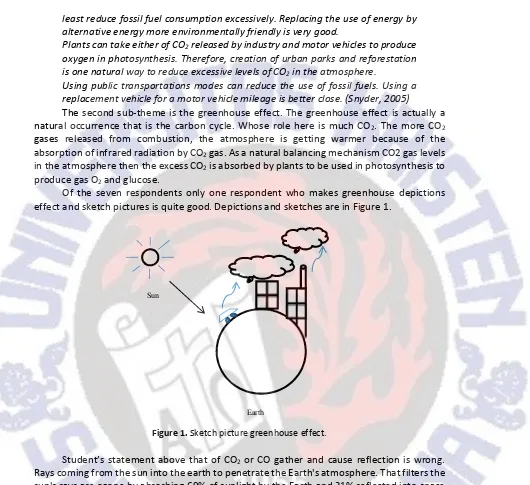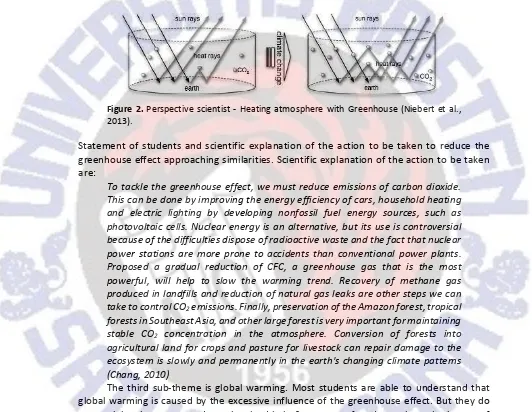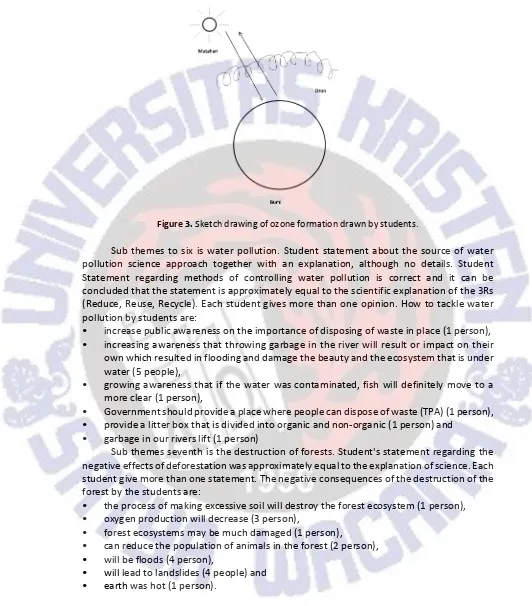Analysis of understanding concept of science literacy course students
take integrated science theme of sustainable development
Sulistiawati1, Ahmad Mudzakir2, Wahyu Sopandi3, Riandi4
1Student of Science Education’s Doctoral Program of Indonesian Education University, Indonesia 2,3,4Lecturer of Graduate in Indonesian Education University, Indonesia
Abstract
One way to explore preconceptions towards a concept can be done through interviews. The results of the interview is expected to provide an overview of pre-conceptions and attitudes of students. The purpose of give question is to explore the concept of understanding the scientific literacy of students regarding the flue gas, greenhouse effect, global warming, acid rain, ozone, water pollution and deforestation. Respondents were math students who have taken courses Integrated Science consists of 7 respondents (3 men - men and 4 women). Activities conducted on March 12, 2015. The concept of student owned then by explaining science taken from several science books. The results showed that the students understood the concept is the concept of exhaust gas, water pollution and deforestation. While the concept of the greenhouse effect, global warming, acid rain and ozone occurs misconceptions.
Keywords model of education reconstruction, sustainable development
1.
Introduction
This article is part of a dissertation author entitled "Reconstruction of the Integrated Science Learning Using Sustainable Development Theme to Improve scientific literacy of students." Reconstruction of science learning is part of the reconstruction of education. Reconstruction of education for learning science should ideally start from curriculum reform as practiced in the United Kingdom since the 1950s (Dillon, 2009) and in Thailand began in 1999 (Yuenyong & Narjaikaew, 2009). However reconstruct one material or one sub-material can also be done. Reconstruction of learning undertaken following Model of Education Reconstruction (MER) developed by Duit et al. (2012). This model on the outline rests on three key components: 1) Analysis of the structure of content: clarification of the subject matter and educational significance analysis, 2) Research of teaching and learning: Pre-conceptions and attitudes of students, 3) Implementation and evaluation of teaching and learning settings authentic in the classroom.
SWUP To see how far the understanding of the concept of student-owned is right or wrong, the understanding of concepts derived from the interviews will be compared to the concept of scientists in the form of scientific explanation. The scientific explanation is taken from several books.
Sustainable development is development that has an impact on economic development and the allocation of natural resources is equitable without making the environment is reduced function because of social pressure on natural systems (such as soil fertility, water and air) for the next life. There are eight Focus Sustainability (sustainability) (Raven et al., 2013), namely: the stability of the human population, pollution prevention possibilities, repairing damage to the environment, preserve natural ecosystems, use resources efficiently, education for future generations, prevent and reduce waste, eliminate hunger and poverty.
One of the sustainability focus is education for future generations. Incorporate the theme of sustainable development in Integrated science teaching is one way of doing education for future generations. The common theme is that researchers select the sub-theme of sustainable development of exhaust gas, greenhouse effect, global warming, acid rain, ozone, water pollution and deforestation. This theme was taken as close to real life - day and often incorrect understanding of the concept.
2.
Materials and methods
The proposed interview questions have been validated by experts. The purpose of the provision of this question is to explore the understanding of the concept of scientific literacy of students. These questions try to explore the concept of student on exhaust gas, greenhouse effect, global warming, acid rain, ozone, water pollution and deforestation. Respondents were math students who have taken courses Integrated Science in the first half. Researchers took seven respondents (3 males - males and 4 females). The event was held on March 12, 2015.
3.
Results and discussion
The question given to respondents consisted of 25 questions. Most respondents provide more than one explanation for a question.
The first sub-theme is exhaust. Statement of student and scientific explanation of the exhaust gas is almost the same. Only, more detailed scientific explanation and clearer. Explanation of science of the exhaust gases are:
Pollution was divided into two groups: primary air pollution and air pollution secondary. Primary air pollution is a gas that is discharged directly into the atmosphere which is the remainder of the activity at the Earth's surface such as exhaust fumes, factory exhaust fumes, volcanoes etc. The pollutants are CO, CO2
, SO2 , NO, NO2 , hydrocarbons and particles. Secondary air pollution is a new
pollutant that is formed from primary pollutants earlier. The pollutant is HNO2,
HNO3, H2O2, SO2, H2SO4, salt - salt, etc. (Revan et al., 2013).
Statement of students and scientific explanation of the action that should be taken to reduce air pollution is almost the same. Scientific explanation of the actions to be taken are:
least reduce fossil fuel consumption excessively. Replacing the use of energy by alternative energy more environmentally friendly is very good.
Plants can take either of CO2 released by industry and motor vehicles to produce oxygen in photosynthesis. Therefore, creation of urban parks and reforestation is one natural way to reduce excessive levels of CO2 in the atmosphere.
Using public transportations modes can reduce the use of fossil fuels. Using a replacement vehicle for a motor vehicle mileage is better close. (Snyder, 2005)
The second sub-theme is the greenhouse effect. The greenhouse effect is actually a natural occurrence that is the carbon cycle. Whose role here is much CO2. The more CO2 gases released from combustion, the atmosphere is getting warmer because of the absorption of infrared radiation by CO2 gas. As a natural balancing mechanism CO2 gas levels in the atmosphere then the excess CO2 is absorbed by plants to be used in photosynthesis to produce gas O2 and glucose.
Of the seven respondents only one respondent who makes greenhouse depictions effect and sketch pictures is quite good. Depictions and sketches are in Figure 1.
Figure 1. Sketch picture greenhouse effect.
Student’s statement above that of CO2 or CO gather and cause reflection is wrong. Rays coming from the sun into the earth to penetrate the Earth's atmosphere. That filters the sun's rays are ozone by absorbing 69% of sunlight by the Earth and 31% reflected into space (Reven et al., 2013). Light absorbed by the earth is absorbed by CO2 and spread to the entire surface of the earth in the form of heat (Chang, 2010).
Scientific explanation is more easily digested in schematic form the container. Niebert (2013) explains that the use of container schemes, the atmosphere is conceptualized as a forum to describe the flow of radiation between the inside and the outside. In addition, the balance scheme is used to describe the balance between flow in and flow out. With the conception of the container's atmosphere Earth's surface is described as a lower limit and the outer limit is at the altitude at which changes occur, for example tropopause. Interior consists of a gas container. Outer limit is taken to describe and measure the flow of energy between the atmosphere and space. Earth's surface is conceptualized as the lower limit of the container, which is crossed by energy and gas. Scientists consider the radiation as electromagnetic energy, which has a wide range of wavelengths and frequencies associated
Sun
C
SWUP
in a continuous spectrum. Relevant differences in the solar radiation drawn between visible light (short wavelength part of the spectrum) and heat (infrared radiation). Visible light is absorbed by the earth's surface and re-emitted as infrared radiation. Visible light passing through CO2 unaffected, but the infrared radiation interacts with CO2, causing an increase in temperature. Rising levels of CO2 in the atmosphere absorbs more infrared radiation in the atmosphere. The more CO2 in the atmosphere, the more radiation is absorbed. We call this conception of global warming by atmospheric Greenhouse (Niebert et al., 2013).
Figure 2. Perspective scientist - Heating atmosphere with Greenhouse (Niebert et al., 2013).
Statement of students and scientific explanation of the action to be taken to reduce the greenhouse effect approaching similarities. Scientific explanation of the action to be taken are:
To tackle the greenhouse effect, we must reduce emissions of carbon dioxide. This can be done by improving the energy efficiency of cars, household heating and electric lighting by developing nonfossil fuel energy sources, such as photovoltaic cells. Nuclear energy is an alternative, but its use is controversial because of the difficulties dispose of radioactive waste and the fact that nuclear power stations are more prone to accidents than conventional power plants. Proposed a gradual reduction of CFC, a greenhouse gas that is the most powerful, will help to slow the warming trend. Recovery of methane gas produced in landfills and reduction of natural gas leaks are other steps we can take to control CO2 emissions. Finally, preservation of the Amazon forest, tropical forests in Southeast Asia, and other large forest is very important for maintaining stable CO2 concentration in the atmosphere. Conversion of forests into agricultural land for crops and pasture for livestock can repair damage to the ecosystem is slowly and permanently in the earth's changing climate patterns (Chang, 2010)
The third sub-theme is global warming. Most students are able to understand that global warming is caused by the excessive influence of the greenhouse effect. But they do not explain what compounds are involved in it. Statement of students about the impact of global warming science approximately equal to the science explanation. A scientific statement on the impact of global warming is:
Global warming could cause dramatic changes to flooding in coastal areas, agricultural production, the distribution of infectious diseases, rainfall, the number and intensity of storms, and other factors that affect the welfare of the community. (Trefil, 2010)
The fourth sub-theme is acid rain. Statement of students that SO and H2O to form sulfuric acid was wrong. Statements about the source of acid rain has been approximately equal to the explanation of science. None of the students could make a sketch of the formation of acid rain and reactions such as science explanation. While the description of the effects of acid rain are correct. Almost every student give more than one opinion. Effect of acid rain according to the following students:
• aquatic ecosystem is damaged, lots of fish, plants and microorganisms die (5 person), • toxic to plant roots that will cause disruption of the growth or development of plants (4
people),
• damaging the animal's skin, causing death or extinction (1 person),
• on building materials made of steel or iron exposed to acid will experience corrode (1 person),
• damage human skin (4 people),
• damage to the soil so that damage plants (1 person) • do not know (1 person).
Methods of controlling acid rain given the student is correct. It's just a student explanation is not supported by chemical reactions. Explanation students are:
• forest burning illegally deducted (1 person),
• reduce the use of motor vehicles and keep the environment (1 person),
• the plant must filter out the smoke to be done perfectly before discharge (1 person) • do not know (4 people).
Sub themes to five is ozone. All students (respondents)) does not understand how to properly ozone formation. Nonetheless, there are trying to present the argument. One of the arguments:
SWUP Figure 3. Sketch drawing of ozone formation drawn by students.
Sub themes to six is water pollution. Student statement about the source of water pollution science approach together with an explanation, although no details. Student Statement regarding methods of controlling water pollution is correct and it can be concluded that the statement is approximately equal to the scientific explanation of the 3Rs (Reduce, Reuse, Recycle). Each student gives more than one opinion. How to tackle water pollution by students are:
• increase public awareness on the importance of disposing of waste in place (1 person),
• increasing awareness that throwing garbage in the river will result or impact on their
own which resulted in flooding and damage the beauty and the ecosystem that is under water (5 people),
• growing awareness that if the water was contaminated, fish will definitely move to a
more clear (1 person),
• Government should provide a place where people can dispose of waste (TPA) (1 person),
• provide a litter box that is divided into organic and non-organic (1 person) and
• garbage in our rivers lift (1 person)
Sub themes seventh is the destruction of forests. Student's statement regarding the negative effects of deforestation was approximately equal to the explanation of science. Each student give more than one statement. The negative consequences of the destruction of the forest by the students are:
• the process of making excessive soil will destroy the forest ecosystem (1 person),
• oxygen production will decrease (3 person),
• forest ecosystems may be much damaged (1 person),
• can reduce the population of animals in the forest (2 person),
• will be floods (4 person),
• will lead to landslides (4 people) and
4.
Conclusions and remarks
The results showed that the concept is easy to understand the student is the concept of exhaust gases, water pollution and deforestation. While the concept of the greenhouse effect, global warming, acid rain and ozone occurs misunderstanding. This is because the fourth is in the form of abstract concepts. Keep in the development of learning model that can overcome this misconception.
References
Chang, R. (2010). Chemistry (10th ed.). McGraw-Hill Companies.
Dillon, J. (2009). On scientific literacy and curriculum reform. International Journal of Environmental
and Science Education, 4(3), 201–213.
Duit, R. (1995). A Model of educational reconstruction. Paper presented at the annual meeting of the
National Association of Research in Science Teaching (NARST), San Francisco.
Duit, R. (2007). The model of educational reconstruction – A framework for improving instructional
planning and Science education research. IPN-Leibniz-Institute fors Science Education.
Duit, R. (2012). The model of Educational Reconstruction – A Framework for Improving Teaching and
Learning science. Science education research and practice in Europe: Retrospective and
Prospective, Rotterdam: Sense Publishers.
Laherto A (2012). Nanoscience education for scientific literacy opportunities and challenges in
Secondary School and in Out-of-School settings (unpublished dissertation). Department of Physics, Faculty of Science, University of Helsinki.
Niebert, K., & Gropengiesser, H. (2013). The model of educational reconstruction: A framework for the
design of theorybased content specifi interventions. The example of climate change. In T. Plomp,
& N. Nieveen (Eds.), Educational design research – Part B: Illustrative cases.
Raven, P.H., Hassenzahl, D.M., & Berg, L.R. (2013). Environment (8th ed.). John Wiley and Sons.
Snyder, S.L. (2005). Glencoe science: The air around you. McGraw-Hill Companies.
Trefil, J. (2010). The science (6th ed.). John Wiley and Sons.
Viiri, J., & Savinainen, A. (2008). Teaching-learning sequences: A comparison of learning demand
analysis and educational reconstruction. Lat. Am. J. Phys. Educ., 2(2).
Westbroek, H.B. (2005). Characteristics of meaningful chemistry education. Springer.
Yuenyong, C., & Narjaikaew, P. (2009). Scientific literacy and Thailand science education. International


